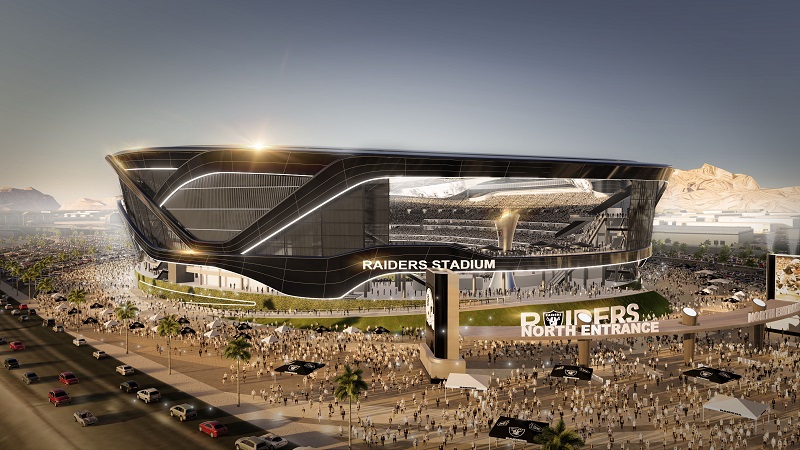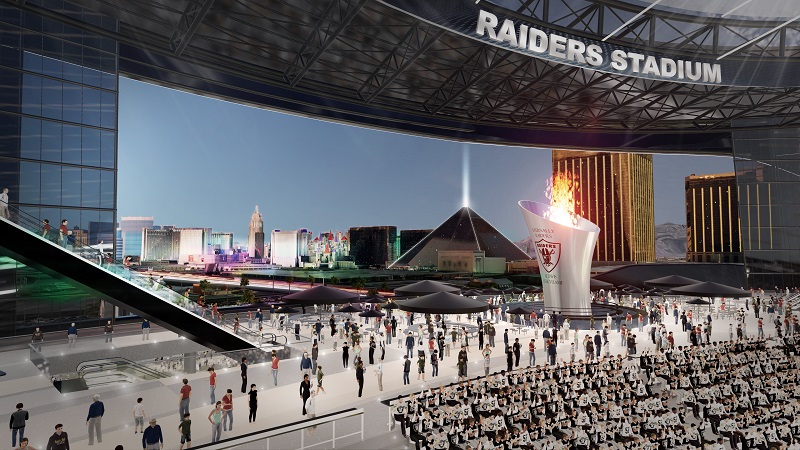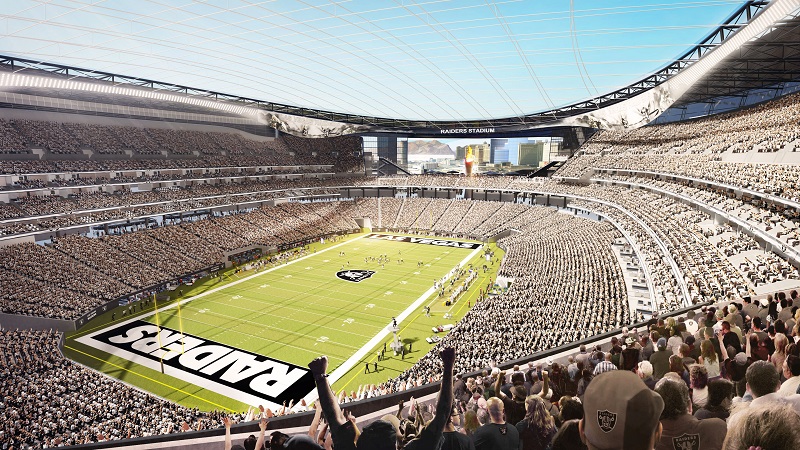Las Vegas NFL stadium
In January 2017, designs were published for an NFL stadium in Las Vegas. Designed by MANICA Architecture, the stadium is intended for the Oakland Raiders who may relocate to the city.
In December 2016, the city of Oakland presented plans to replace the Coliseum, which has been the team’s home ground since 1966, with a new $1.6 billion venue. Las Vegas is currently without its own NFL team, and is hoping to entice the Oakland team with the new stadium.
The modernist stadium design incorporates a horseshoe-shaped seating arrangement with an open side to the north, offering views onto the famous Las Vegas Strip. The natural turf field will be retractable. The domed and air-conditioned stadium will be topped with a transparent roof and hold a capacity of 65,000 seats, expandable to 72,000 for SuperBowl events.
Sleek black bands curve around the structure, while at the centre of the open end a tower will house a ‘flaming cauldron’.
Although details about the project are fairly scant, the graphic images show the stadium close to the Strip’s south end, behind the Mandalay Bay resort. The site, near the freeway and airport, allows for easy access with provision for an 8,000-capacity car park, tailgating amenities, and a mixed-use commercial development.
According to a report from the South Nevada Tourism Infrastructure Committee, the project is estimated to cost $1.9 bn. The state has reportedly approved $750 million for the new stadium, Raiders owner Mark Davis has pledged $500m, and casino mogul Sheldon Adelson is apparently to contribute $650m.
Along with the economic benefits of in-season games, constructing the venue would also allow Sin City to host the annual Super Bowl event – which would bring in hundreds of millions of dollars.
The stadium is currently targeted for completion in advance of the 2020 NFL season.
Image and content courtesy MANICA Architecture.
[edit] Related articles on Designing Buildings Wiki
Featured articles and news
One of the most impressive Victorian architects. Book review.
RTPI leader to become new CIOB Chief Executive Officer
Dr Victoria Hills MRTPI, FICE to take over after Caroline Gumble’s departure.
Social and affordable housing, a long term plan for delivery
The “Delivering a Decade of Renewal for Social and Affordable Housing” strategy sets out future path.
A change to adoptive architecture
Effects of global weather warming on architectural detailing, material choice and human interaction.
The proposed publicly owned and backed subsidiary of Homes England, to facilitate new homes.
How big is the problem and what can we do to mitigate the effects?
Overheating guidance and tools for building designers
A number of cool guides to help with the heat.
The UK's Modern Industrial Strategy: A 10 year plan
Previous consultation criticism, current key elements and general support with some persisting reservations.
Building Safety Regulator reforms
New roles, new staff and a new fast track service pave the way for a single construction regulator.
Architectural Technologist CPDs and Communications
CIAT CPD… and how you can do it!
Cooling centres and cool spaces
Managing extreme heat in cities by directing the public to places for heat stress relief and water sources.
Winter gardens: A brief history and warm variations
Extending the season with glass in different forms and terms.
Restoring Great Yarmouth's Winter Gardens
Transforming one of the least sustainable constructions imaginable.
Construction Skills Mission Board launch sector drive
Newly formed government and industry collaboration set strategy for recruiting an additional 100,000 construction workers a year.
New Architects Code comes into effect in September 2025
ARB Architects Code of Conduct and Practice available with ongoing consultation regarding guidance.
Welsh Skills Body (Medr) launches ambitious plan
The new skills body brings together funding and regulation of tertiary education and research for the devolved nation.
Paul Gandy FCIOB announced as next CIOB President
Former Tilbury Douglas CEO takes helm.


























